Thanks for your support! If you make a purchase using our links in this article, we may make a commission. And, as an Amazon Associate, I earn from qualifying purchases. See the full disclosure here.
Can RV refrigerator fans make your fridge cooler? Yes, they will do a good job of making your fridge cooler. However, to get the best results, it is best to use a circulating fan inside the fridge and a vent fan on the outside of the refrigerator.
As we work our way through this article we will discuss in more detail:
- The two types of RV refrigerator fans (Cooling and Vent Fans)
- How each of these fans works
- Tips to keep your RV refrigerator working efficiently in hot weather
- Proper temperatures for your RV fridge and freezer
- Best RV fridge cooling fans
- Best RV fridge vent fans
- Best thermometers for inside an RV fridge and freezer
- A video that shows how to install an RV Fridge Cooling Fan and an RV Fridge Vent Fan
Once you are done reading and watching the video at the end of the article, we hope you will have all the knowledge you need to get your RV refrigerator fans up and running.
The Two Types of RV Refrigerator Fans
Type 1: RV Fridge Cooling Fan (or Circulating Fan)
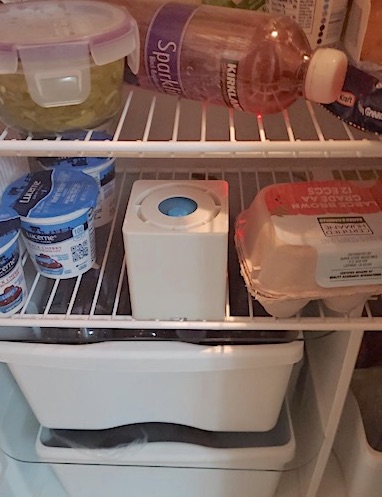
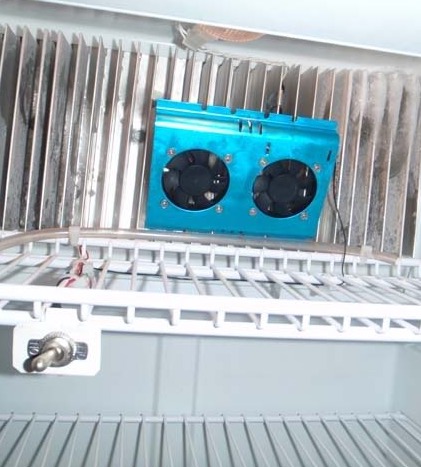
An RV Fridge Cooling fan is a fan that is located inside the refrigerator. It blows air around inside your fridge and makes the fridge more efficient. They can either be battery powered and sit on a shelf inside the fridge or they can run on 12-volt electricity and mount directly to the silver fins inside the fridge. Here’s how these cooling fans work.
If your RV has a propane style refrigerator, then you probably have fins that protrude inside the fridge. These fins get very cold by absorbing the heat from the air.
For the most part, fridge fin fans rely on natural convection air currents to cool the air. Although this method of cooling is ok, some areas of the RV refrigerator can get too cold, which causes food to freeze and other areas may be too warm.
Type 2: RV Refrigerator Exterior Ventilation Fans
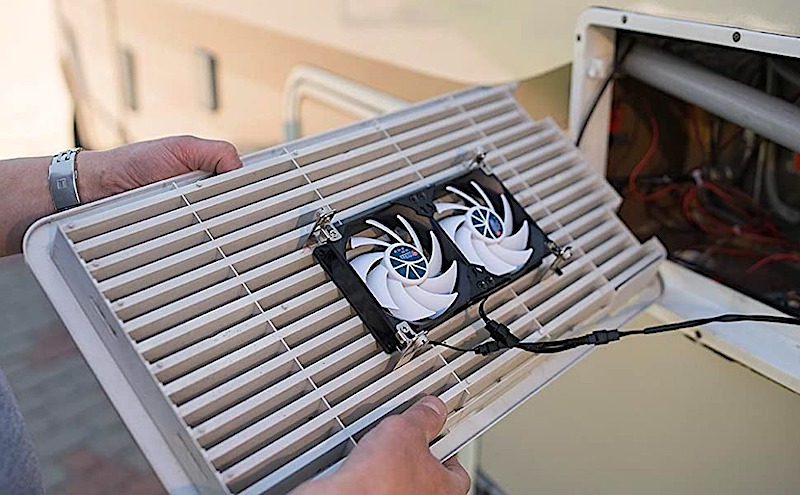
An RV refrigerator vent fan is installed outside of the RV and it pulls warm air around the exterior of the refrigerator and blows it outside the RV. These fans are typically mounted inside the vent cover on the side or on the roof of an RV.
Like with everything in an RV, your RV will heat up on hot summer days. If you happen to be parked at a campsite that has the refrigerator side of the RV facing the sun, you will definitely notice this. This is when a vent fan will come in real handy!
Why Do RV Refrigerators Need Cooling Fans?
Most RV refrigerators are absorption refrigerators. What this means is that they cool by a process of absorption – removing the heat inside the unit to keep food cool. These refrigerators work well in mild climates, but sometimes they need a little help.
RV refrigerator fans help keep your refrigerator cool in different ways. Interior fridge fans help to circulate air around the refrigerator, which helps with the removal of heat.
Exterior RV fridge vent fans help keep fresh air moving around the coils in the back of your refrigerator. This helps cool things down so your fridge can do its job more efficiently.
If you’ve ever noticed that your RV refrigerator doesn’t stay as cold in the summertime or when there is direct sunlight on your RV fridge vents, an RV refrigerator fan might be a smart investment for you.
What is an RV Refrigerator Cooling Fan?
The RV refrigerator cooling fan is located inside the fridge, and it blows cold air around to maintain consistent low temperatures.
This fan is very important for the performance of your fridge. Without a cooling fan, the inside of your fridge may not stay as cool as it could. So, a cooling, or circulating fan just blows the air around inside your fridge which helps the fridge to be more efficient.
How Do Refrigerator Cooling Fans Work?
The refrigerator cooling fan is the fan that resides inside your fridge. It is responsible for keeping the inside of your fridge at a set temperature. While you may understand what it does, you might not know how it does it.
Cooling fans are very simple devices that perform a simple task. They have a sensor that detects the temperature of the inside of your fridge that detects the temperature. When the temperature starts to rise above the desired temperature, the fan turns on.
They then work to cool down the fridge by blowing cold air around. They do this constantly to maintain consistently lower temperatures.
12v RV Refrigerator Fans vs Battery Powered RV Fridge Cooling Fans
There are 2 types of RV fridge cooling fans. One is a battery operated fan that sits on a shelf inside the fridge and the other is a 12-volt fan that attaches to the fins inside the refrigerator.
Important Pro Tip: Forgetting to turn off the fan when it is not in use, could cause you to replace its battery frequently.
Another important thing to know about the 12-volt fans is that they come in single, double, or triple fan racks. The double and triple fan racks are most often connected to the RV’s power source or you can connect to a solar panel. They usually require a little more power to run, however.
What is an RV Refrigerator Vent Fan?
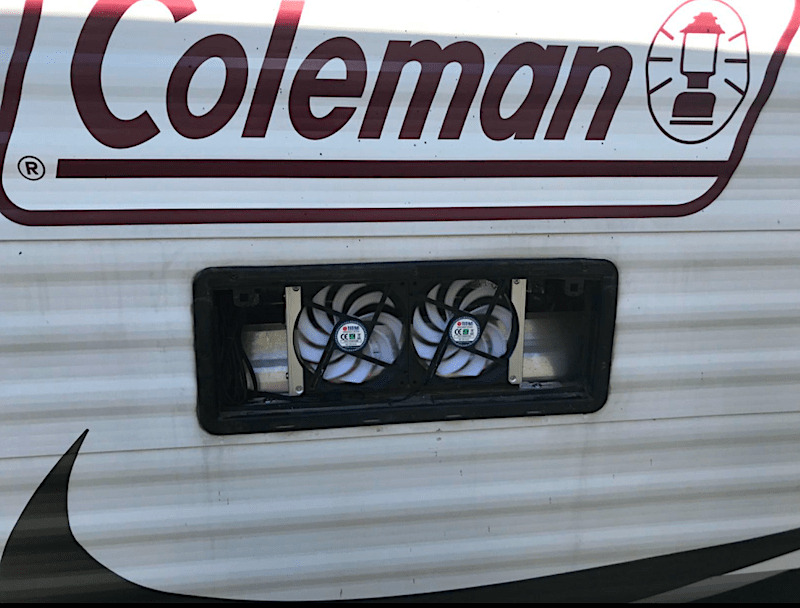
The RV refrigerator vent fan is located on the outside of the fridge. It removes hot air around the outside of the refrigerator which allows it to be more efficient. This is extremely important in an RV because the temperature in your RV is always in flux.
When the air outside your fridge is hot your fridge will have to work harder to keep everything cool on the inside. So, a refrigerator vent fan removes the warm air around the fridge to help it function more efficiently.
Tips to Keep Your RV Refrigerator Working in Hot Weather
What is your RV’s worst nightmare? Hot, sunny days.
We touched on this above when you are parked with your RV refrigerator side facing the sun. But no need to fear, we have some simple yet effective solutions.
The Ultimate Checklist to Keep Your RV Refrigerator Working in the Summer:
- Install the proper RV refrigerator fan to keep the cold air circulating in your rig
- If possible, park your RV so the fridge side is in the shade away from the sun
- For shorter trips, run your RV fridge on propane. This will be the best way to get cooler temps inside your RV refrigerator as well as work more efficiently than if it was running on electricity.
- Install an RV Fridge vent fan to evacuate any warm air around the outside of the fridge.
What Temperature Should an RV Refrigerator Be?
To keep the food inside your RV refrigerator safe, you will need to maintain a temperature of between 34 and 43 degrees Fahrenheit. An easy way to keep an eye on that temperature is to have a thermometer hanging from one of the shelves in the fridge.
However, even though we provided a wider range, it is slightly better to keep the temperature between 38 and 41 degrees. That is because some things will start to freeze once the temperature hits 37 degrees. Things like veggies, fruits, and eggs will begin to freeze at this point. Additionally, letting the temperature get to the higher end of the range means you will be closer to risking things spoiling.
Furthermore, you need to remember that for every minute the RV refrigerator door is open, it takes one hour for it to recover that cold temperature completely. As a result, you should avoid leaving your fridge open for extended periods of time, or you will risk the food in your fridge going bad.
Additionally, if you are planning on placing a lot of foods and beverages in your fridge, you should cool the fridge down first. Our RV fridge takes 12 hours to cool down to 39 degrees so we usually turn it on the night before we pack our food when we go away.
We also refrigerate everything we can before placing it in the RV fridge. This helps the RV fridge maintain its temperature too.
What Are the Best RV Refrigerator Cooling Fans?
Keeping your RV refrigerator cool is incredibly essential. Without a cool fridge, almost all your food could go bad. As a result, you need to make sure that your fridge has a good RV refrigerator cooling fan. There are many options out there, so we picked the best battery operated and 12-volt options for you to consider.
1. Beech Lane Fridge Fan
The Beech Lane Fridge Fan is one of the best battery operated RV refrigerator cooling fans on the market. It has a high power, 3000 r/m motor. Many competitor versions use around 700 r/m motors, but Beech Lane uses a higher power motor to give the most power and airflow inside your fridge.
The fan is built to be durable and is constructed with high-quality materials to ensure that it does not break down when working hard. It is also easy to use as it can be turned on and off with a switch. You can turn it off whenever you want to save battery life.
RV refrigerators are notorious for having bad circulation, so it is important to have an accessory like this one. It will help ensure that cold air is circulating throughout the fridge and not just falling to the bottom. This way, you can rest easy knowing nothing will be expiring and spoiling.
This product comes with a lifetime manufacturer warranty. If this RV refrigerator fan ever fails or is damaged, then it is covered by the manufacturer.
2. Dutchaire RV Refrigerator Fin Fan
The Dutch Aire RV Refrigerator Fin Fan is the best 12-volt RV refrigerator fan on the market. It has a frost-free design, meaning you do not need to worry about snow or ice building up on the fan. With a lot of fans that can happen, and when it does, it causes the sensor to malfunction.
If the sensor is covered in frost, it will be unable to detect the temperature of your fridge as a whole. As a result, your fridge will not be kept at the right temperature.
What Are the Best RV Refrigerator Vent Fans?
Vent fans are very important for RV refrigerators because, as we mentioned, they typically have poor circulation around them compared to household fridges. As a result, your RV fridge will need to work extra hard to regulate the temperature. A vent fan will remove hot air surrounding the fridge. Here is the best RV refrigerator vent fan on the market.
1. Titan Waterproof Ventilation Cooling Fan
The Titan Waterproof Ventilation Vent Fan is a great vent fan for your RV refrigerator. It has a flexible and smart speed control. You will have the ability to adjust the speed of the fan between six levels. So, you can have it working at different levels to suit your needs. Additionally, it is suitable for outdoor use as it is an IP 55 waterproof and dustproof fan. It also has a rack hook design that makes it easy to install.
Furthermore, Titan puts an emphasis on customer service. As a result, they guarantee a free replacement for a fan that has shipping problems or one that has any uncontrolled defects or issues. You can also contact them for free if you have any questions.
Monitor Your RV Refrigerator Temperature By Installing Thermometers In The Fridge and Freezer
After you install your fans, you might think you are ready to get things going. However, it is important to take one more precaution before you get on the road. You will want to install thermometers in your fridge and freezer.
While the fans should do everything for you and ensure that your fridge is at the right temperature, there is always the chance that something could fail. If that happens, then you will have a lot of spoiled food on your hands very soon. However, if you purchase a few thermometers, then you will be able to always see the temperature for yourself. This should put your mind at ease, knowing that everything is working as it should.
1. Gejoy 2 Pack Refrigerator Freezer Thermometer Large Dial Thermometer
We do not need to get in-depth when it comes to thermometers. It is difficult for a manufacturer to make a thermometer that is defective. However, there are a few things that you can look for that will make your life a little easier.
First, you want to find thermometers that do not require batteries. Then you will want to find a set that comes in a pack. This way you can get one for your fridge and one for your freezer.
We are fans of these thermometers because no batters are required, and they come in a two-pack. So, you will have one for your fridge and freezer!
What You Need to Know About RV Refrigerator Fans and Vents
Each of these fans plays an important role in helping your fridge run as cool as possible. You could use one or the other but we recommend you use both types of fans for maximum efficiency.
It is also extremely important that your RV is as level as possible in all directions in order for your RV fridge to function properly. If your camper or RV is not level the fridge may not cool at all and you can seriously damage your refrigerator.
How Do I Install an RV Refrigerator Cooling Fan?
I could try to type it all out for you but check out this terrific video from Eat See RV that goes into great detail about how to install an RV refrigerator cooling fan and an RV refrigerator vent fan. Although they use different fans than what we recommend, the installation is the same for all the products.
Keep Your RV Refrigerator Cool on Your Next Camping Trip
So, can RV refrigerator fans make your fridge cooler? They absolutely can, but you will want to make sure that you have the right type of RV refrigerator fan inside and outside the fridge. You will want a cooling fan on the inside of the fridge. It will detect the temperature and circulate the air throughout the fridge. This will ensure that the cold air does not fall to the bottom. If that were to happen the food at the top of your refrigerator would spoil.
Additionally, it would be best if you considered getting an RV refrigerator vent fan. The vent fan will make sure that hot air is eliminated from the area surrounding your fridge. You see, RV fridges are not as efficient as household refrigerators, and as a result, they require a lot of energy to run. It takes even more power when there is hot air surrounding the fridge heating it up. A vent fan will help eliminate that problem by removing hot air in the area.
Once you have your RV refrigerator fans installed, you may be ready to get on the road. However, before you start your trip, you should pick up a few thermometers. While your RV refrigerator fans should be working, there is always a chance they could be defective.
However, if you put thermometers in your fridge and freezer, then you will be able to check the temperature yourself. Then you will not need to worry about anything going wrong, and if it does, you will be able to address the issue immediately.
Have you needed to install RV refrigerator fans before? Are you interested in purchasing any of the products featured above? Where do you plan on visiting on your next trip? Let us know in the comments!
Related Reading About RV Refrigerators
To learn more about RV refrigerators and related topics check out some of our other articles below!
– How Long Will an RV Fridge Run on Propane?
– Can You Put a Residential Fridge in an RV?
– What is a 3 Way RV Fridge and Should You Buy One?
– How Long Does an RV Propane Tank Last (Heat, Fridge, Water)
– How To Keep Your RV Fridge Cold While Traveling
– What Temperature Should My RV Fridge/Freezer Be?
Mike Scarpignato – Bio
Mike Scarpignato created RVBlogger.com over five years ago in 2018 to share all we have learned about RV camping.
Mike is an avid outdoorsman with decades of experience tent camping and traveling in his 2008 Gulf Stream Conquest Class C RV and 2021 Thor Challenger Class A motorhome.
We attend RV Shows and visit RV dealerships all across the country to tour and review drivable motorhomes and towable trailers to provide the best evaluations of these RVs in our blog articles and YouTube videos.
We are 3/4-time RVers who created RVBlogger.com to provide helpful information about all kinds of RVs and related products, gear, camping memberships, tips, hacks and advice.



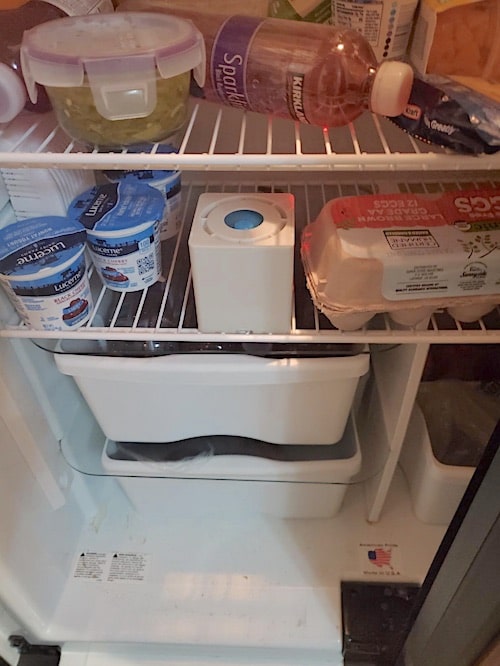
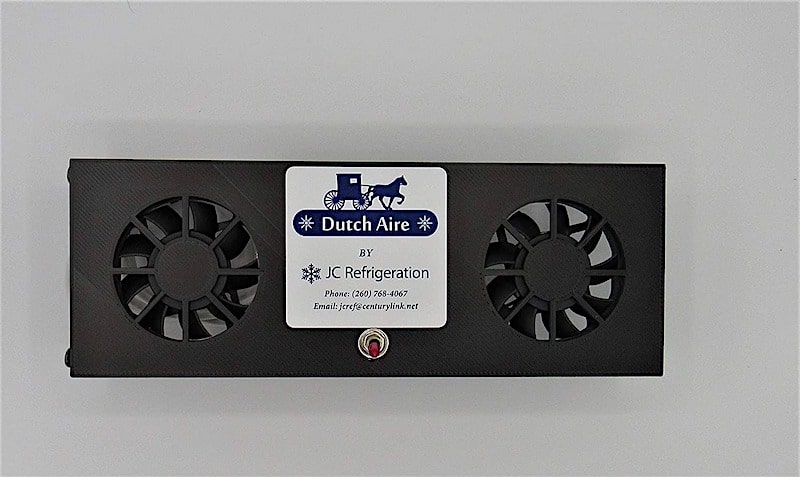


Last fall I had to evacuate my sticks n bricks for 8 days due to a wildfire. I was able to keep my frozen food when I returned because I had a small glass with frozen water with a quarter on top as an indicator if temp got too high and thawed the frozen items.
Befor a recent fire evacuation, I saw a great tip that would show if the freezer was without power long enough to defrost the food. Place a glass of water in freezer. Once water is frozen, place a quarter on top of the ice. If the freezer gets too warm, the quarter will sink in the thawing ice. No guess work if the temperature got too high. I cover the glass in my self-defrosting freezer.